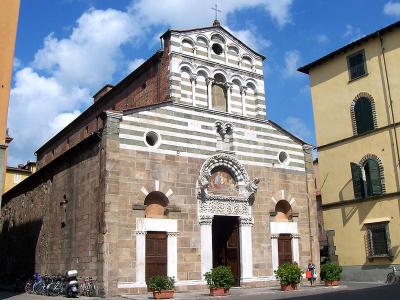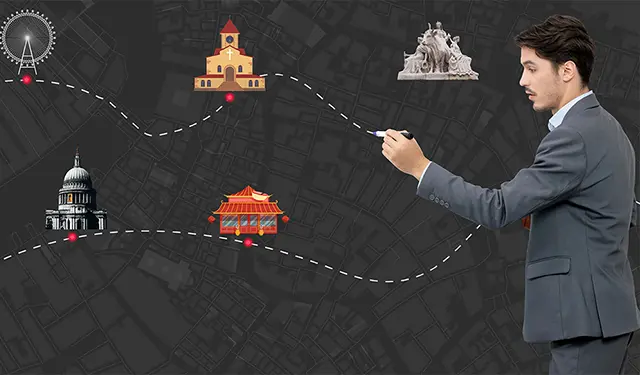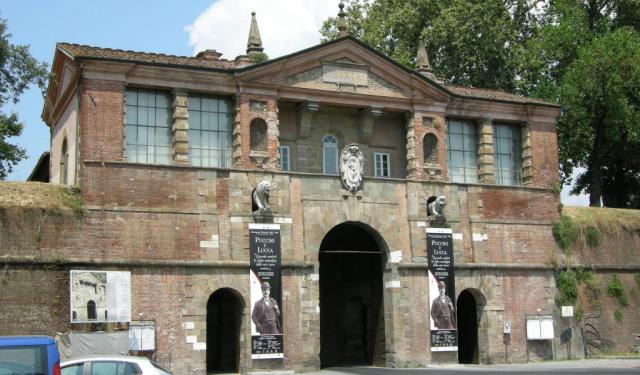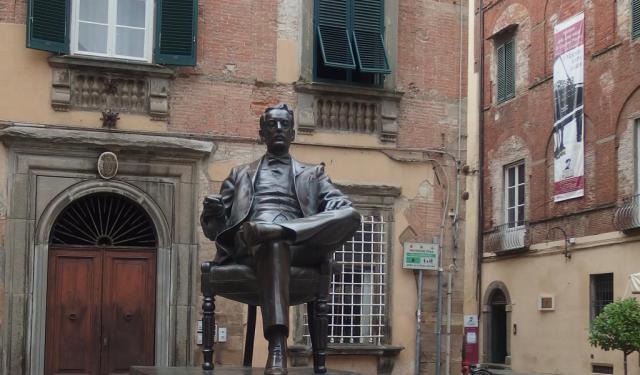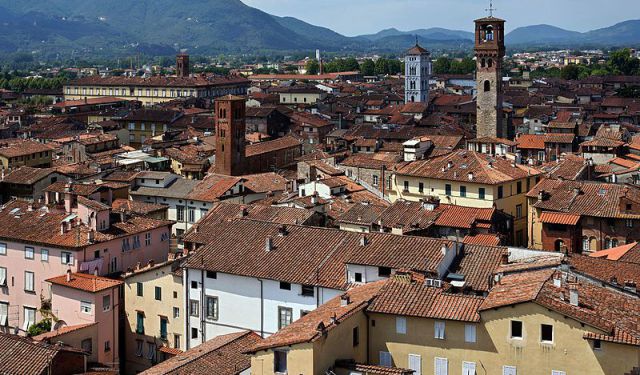Church of San Giusto, Lucca
The Church of San Giusto in Lucca is a striking example of medieval architecture, built in the second half of the 12th century over a pre-existing religious site. The church owes its name to Giustino Salce, a 12th-century Italian figure.
The façade is a masterpiece of Romanesque design, featuring a mixed decorative scheme. The upper part showcases alternating white and black marble stripes, forming two small superimposed loggias-a distinctive feature in Tuscan architecture. The central portal, crafted by Guidetto’s workshop, is particularly notable for its intricate sculptural details. Two twisting atlases (one now partly missing) support protruding lions flanking the lunette, while additional ornamentation includes vegetal motifs, fantastic creatures, and classical mascarons. The archivolt, echoing the upper façade with its black and white pattern, rests on two cubes adorned with masks of Classical origin.
The side portals are more restrained in decoration but maintain the elaborate capitals found in the central entrance. Above them, simple oculi provide balance, while the central doorway is crowned by a double-mullioned window. The apse's exterior features Lombard bands and two levels of single-mullioned windows, adding to the church’s rhythmic elegance.
The interior underwent significant modifications in the 17th century, embracing the Baroque style. However, in the early 20th century, efforts were made to strip away these later additions to restore the church’s presumed original medieval appearance. Fortunately, some elements of the Baroque period were preserved, reflecting a dialogue between historical layers.
A blend of Romanesque grandeur and Baroque refinement, San Giusto stands as a testament to Lucca’s architectural evolution, capturing the essence of its medieval and later artistic transformations.
The façade is a masterpiece of Romanesque design, featuring a mixed decorative scheme. The upper part showcases alternating white and black marble stripes, forming two small superimposed loggias-a distinctive feature in Tuscan architecture. The central portal, crafted by Guidetto’s workshop, is particularly notable for its intricate sculptural details. Two twisting atlases (one now partly missing) support protruding lions flanking the lunette, while additional ornamentation includes vegetal motifs, fantastic creatures, and classical mascarons. The archivolt, echoing the upper façade with its black and white pattern, rests on two cubes adorned with masks of Classical origin.
The side portals are more restrained in decoration but maintain the elaborate capitals found in the central entrance. Above them, simple oculi provide balance, while the central doorway is crowned by a double-mullioned window. The apse's exterior features Lombard bands and two levels of single-mullioned windows, adding to the church’s rhythmic elegance.
The interior underwent significant modifications in the 17th century, embracing the Baroque style. However, in the early 20th century, efforts were made to strip away these later additions to restore the church’s presumed original medieval appearance. Fortunately, some elements of the Baroque period were preserved, reflecting a dialogue between historical layers.
A blend of Romanesque grandeur and Baroque refinement, San Giusto stands as a testament to Lucca’s architectural evolution, capturing the essence of its medieval and later artistic transformations.
Want to visit this sight? Check out these Self-Guided Walking Tours in Lucca. Alternatively, you can download the mobile app "GPSmyCity: Walks in 1K+ Cities" from Apple App Store or Google Play Store. The app turns your mobile device to a personal tour guide and it works offline, so no data plan is needed when traveling abroad.
Church of San Giusto on Map
Sight Name: Church of San Giusto
Sight Location: Lucca, Italy (See walking tours in Lucca)
Sight Type: Religious
Sight Location: Lucca, Italy (See walking tours in Lucca)
Sight Type: Religious
Walking Tours in Lucca, Italy
Create Your Own Walk in Lucca
Creating your own self-guided walk in Lucca is easy and fun. Choose the city attractions that you want to see and a walk route map will be created just for you. You can even set your hotel as the start point of the walk.
Lucca's City Wall and Gates
As one of Italy's Città d'arte's (arts towns), Lucca is famous, among other things, for its well-preserved ancient walls encircling the historic center. From about 570 AD until 1847 the city had been the center of the Longobard administration and the capital of old Tuscany, and as such required a defense system to render it an impenetrable fortress.
Back in the Middle Ages, the... view more
Tour Duration: 2 Hour(s)
Travel Distance: 3.7 Km or 2.3 Miles
Back in the Middle Ages, the... view more
Tour Duration: 2 Hour(s)
Travel Distance: 3.7 Km or 2.3 Miles
Puccini's Lucca
One of the greatest musical talents of mankind, Italian composer Giacomo Puccini, was born and spent a substantial part of his life in the Tuscan city of Lucca. Today the legacy of Puccini resonates all over the world and even more so here.
Puccini's ancestors, also musicians, moved to Lucca in 1719. The future maestro was born in a house that had belonged to his family since 1815 – Casa... view more
Tour Duration: 1 Hour(s)
Travel Distance: 1.5 Km or 0.9 Miles
Puccini's ancestors, also musicians, moved to Lucca in 1719. The future maestro was born in a house that had belonged to his family since 1815 – Casa... view more
Tour Duration: 1 Hour(s)
Travel Distance: 1.5 Km or 0.9 Miles
Lucca Introduction Walking Tour
Lucca is called many things: a city of arts, a city of churches, gardens, towers. Most of all it is known for its walls. From Roman times until now the walls have stood. It is the only city in Italy that has kept its walls intact.
The inner walled city is laid out in the ancient Roman grid plan. The Piazza San Michele is the site of the old forum. Bits of the Roman amphitheater can be found in... view more
Tour Duration: 2 Hour(s)
Travel Distance: 2.9 Km or 1.8 Miles
The inner walled city is laid out in the ancient Roman grid plan. The Piazza San Michele is the site of the old forum. Bits of the Roman amphitheater can be found in... view more
Tour Duration: 2 Hour(s)
Travel Distance: 2.9 Km or 1.8 Miles
